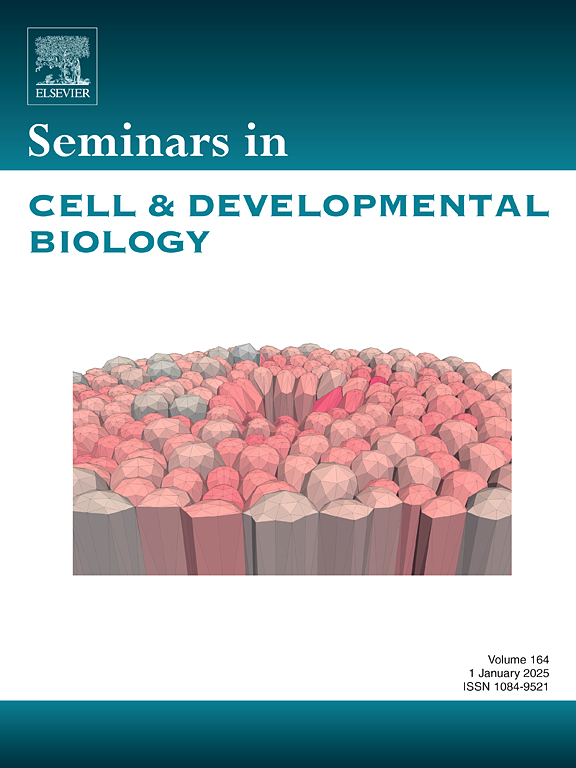Emerging roles for microproteins as critical regulators of endoplasmic reticulum function and cellular homeostasis
IF 6
2区 生物学
Q1 CELL BIOLOGY
引用次数: 0
Abstract
The endoplasmic reticulum (ER) is a multifunctional organelle essential for key cellular processes including protein synthesis, calcium homeostasis, and the cellular stress response. It is composed of distinct domains, such as the rough and smooth ER, as well as membrane regions that facilitate direct communication with other organelles, enabling its diverse functions. While many well-characterized ER proteins contribute to these processes, recent studies have revealed a previously underappreciated class of small proteins that play critical regulatory roles. Microproteins, typically under 100 amino acids in length, were historically overlooked due to size-based biases in genome annotation and often misannotated as noncoding RNAs. Advances in ribosome profiling, mass spectrometry, and computational approaches have now enabled the discovery of numerous previously unrecognized microproteins, significantly expanding our understanding of the proteome. While some ER-associated microproteins, such as phospholamban and sarcolipin, were identified decades ago, newly discovered microproteins share similar fundamental characteristics, underscoring the need to refine our understanding of the coding potential of the genome. Molecular studies have demonstrated that ER microproteins play essential roles in calcium regulation, ER stress response, organelle communication, and protein translocation. Moreover, growing evidence suggests that ER microproteins contribute to cellular homeostasis and are implicated in disease processes, including cardiovascular disease and cancer. This review examines the shared and unique functions of ER microproteins, their implications for health and disease, and their potential as therapeutic targets for conditions associated with ER dysfunction.
微蛋白作为内质网功能和细胞稳态的关键调节因子的新角色
内质网(ER)是一个多功能细胞器,对蛋白质合成、钙稳态和细胞应激反应等关键细胞过程至关重要。它由不同的结构域组成,如粗糙的内质网和光滑的内质网,以及促进与其他细胞器直接通信的膜区域,使其具有多种功能。虽然许多特性明确的内质网蛋白参与了这些过程,但最近的研究揭示了以前未被重视的一类小蛋白,它们起着关键的调节作用。微蛋白通常长度在100个氨基酸以下,由于基因组注释中基于大小的偏差,在历史上被忽视,并且经常被错误地注释为非编码rna。核糖体谱分析、质谱分析和计算方法的进步使许多以前未被识别的微蛋白得以发现,极大地扩展了我们对蛋白质组的理解。虽然一些内质网相关的微蛋白,如磷蛋白和肌磷脂,在几十年前就被发现了,但新发现的微蛋白具有相似的基本特征,这强调了我们需要完善对基因组编码潜力的理解。分子研究表明,内质网微蛋白在钙调节、内质网应激反应、细胞器通讯和蛋白质易位等方面发挥着重要作用。此外,越来越多的证据表明内质网微蛋白有助于细胞稳态,并与疾病过程有关,包括心血管疾病和癌症。本文综述了内质网微蛋白的共同和独特功能,它们对健康和疾病的影响,以及它们作为内质网功能障碍相关疾病的治疗靶点的潜力。
本文章由计算机程序翻译,如有差异,请以英文原文为准。
求助全文
约1分钟内获得全文
求助全文
来源期刊
CiteScore
15.10
自引率
1.40%
发文量
310
审稿时长
9.1 weeks
期刊介绍:
Seminars in Cell and Developmental Biology is a review journal dedicated to keeping scientists informed of developments in the field of molecular cell and developmental biology, on a topic by topic basis. Each issue is thematic in approach, devoted to an important topic of interest to cell and developmental biologists, focusing on the latest advances and their specific implications.
The aim of each issue is to provide a coordinated, readable, and lively review of a selected area, published rapidly to ensure currency.

 求助内容:
求助内容: 应助结果提醒方式:
应助结果提醒方式:


